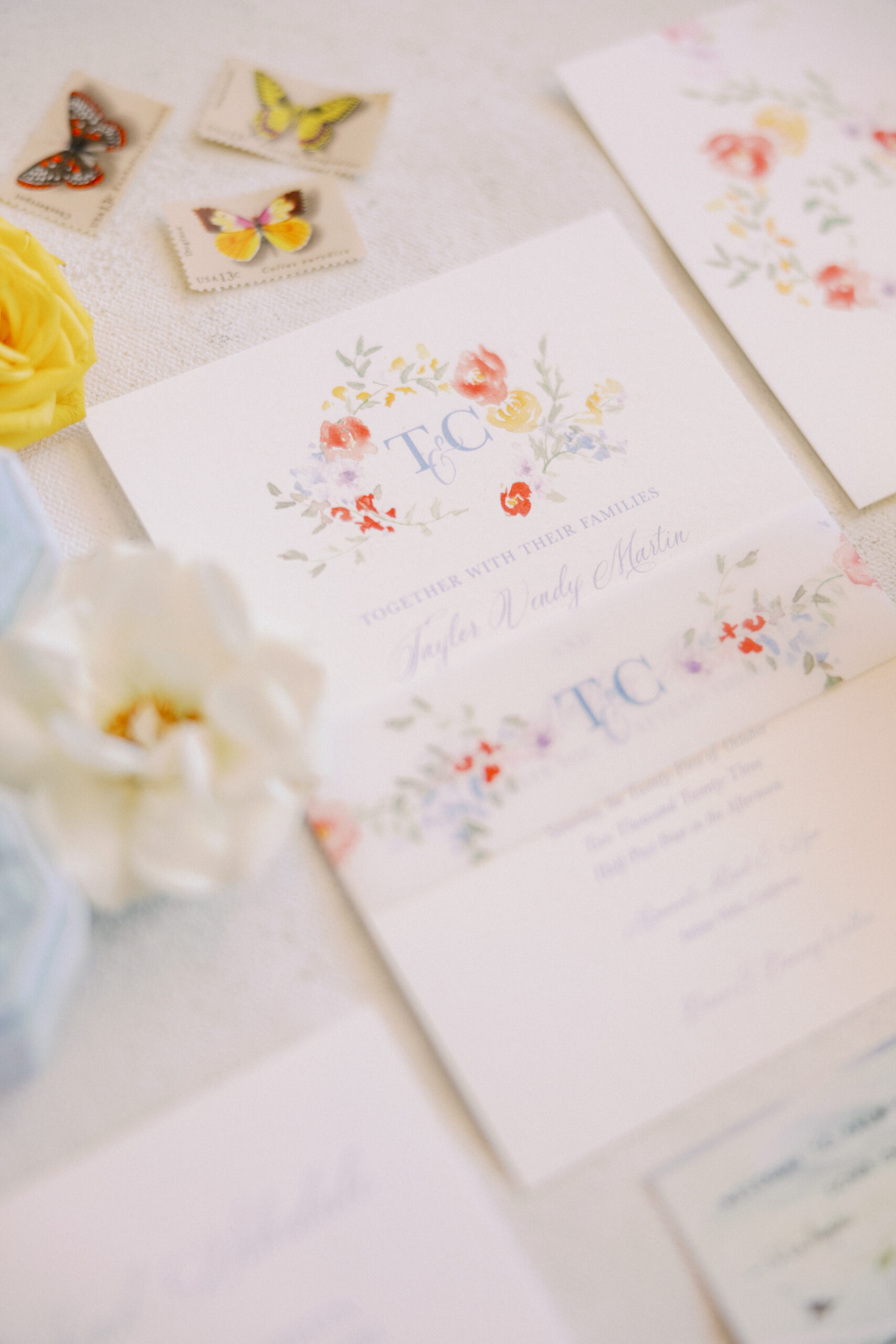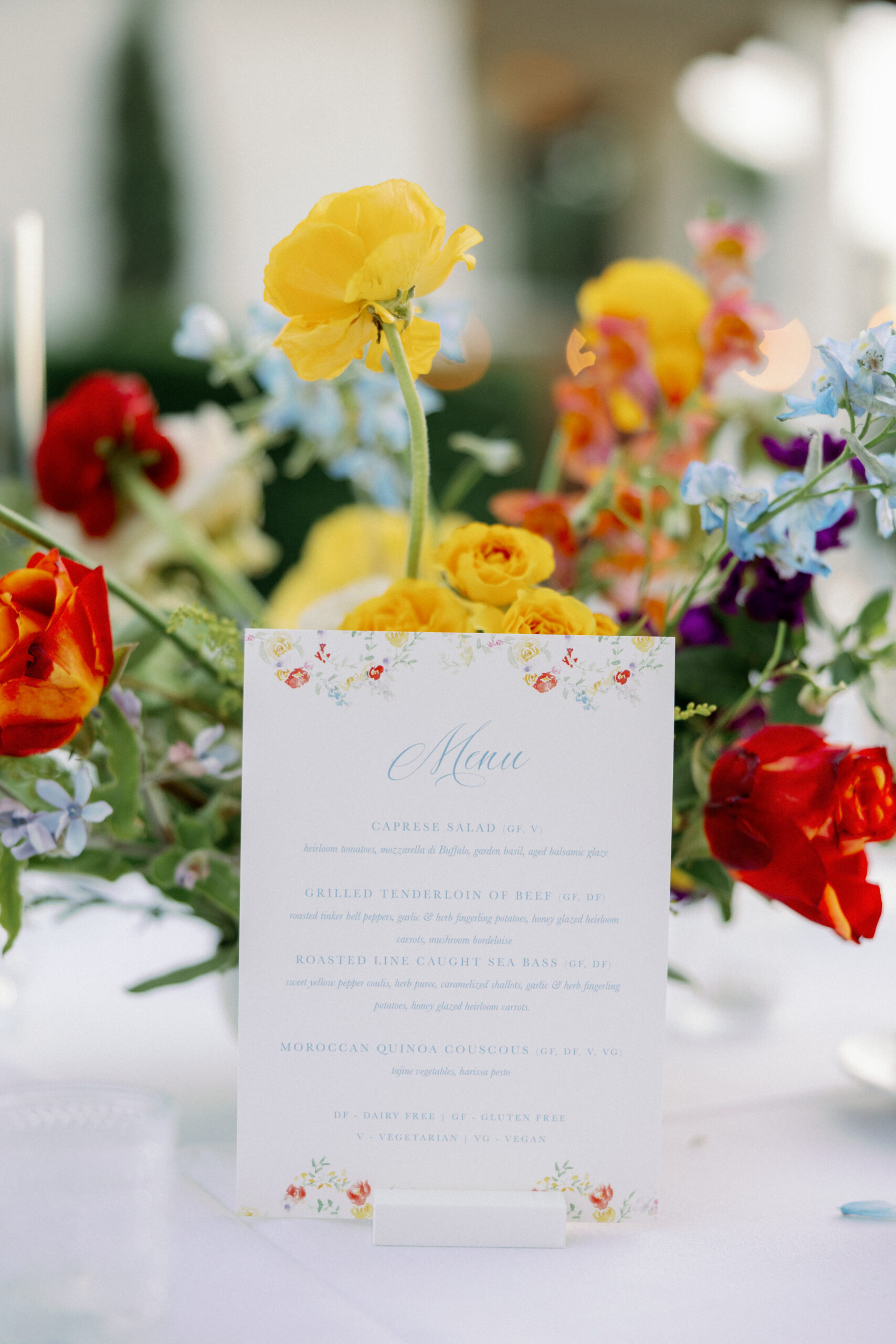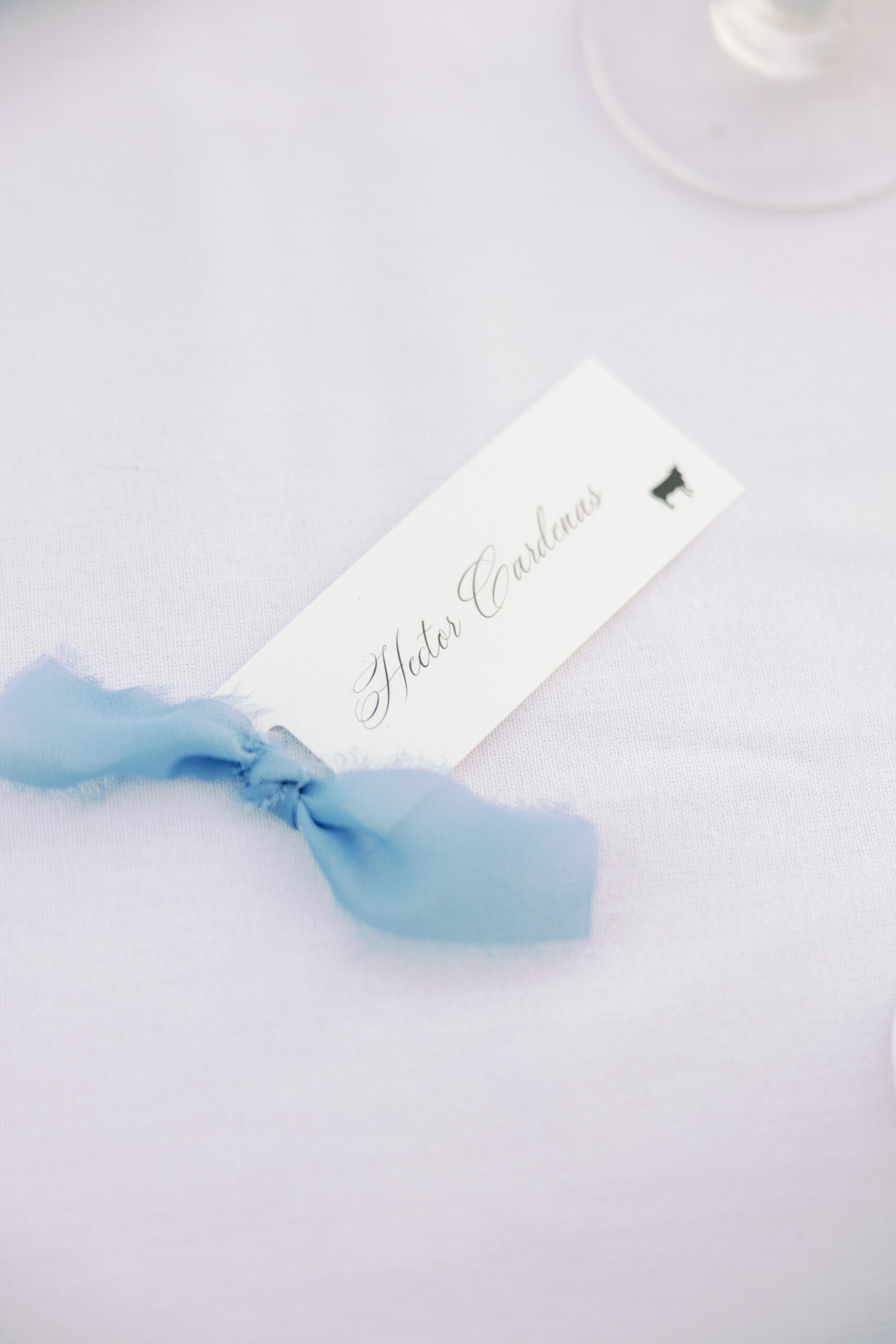Wedding Invitation Wording If The Couple Is Hosting The Wedding
January 9, 2024

Wedding invitation etiquette is one of the first realizations couples have that planning a wedding has a lot more nuance then they once thought. Everything from how you phrase the opening of your invitation, to how you address the envelopes, has significance and implications. And as more and more couples are hosting their own weddings – from the planning to the payments – I get more questions about how to word the wedding invitation and when to use certain phrases like “Together with their families…” Whether your parents or other family members are contributing a large portion of the funds or none at all, there are a few ways to word your wedding invitation to make it clear who is hosting the event and avoid offending anyone with the language you choose.
Traditional Wedding Wording
Traditionally, weddings were often paid for by the bride’s family. Therefore, they were worded in a specific way that addressed the fact that the bride’s parents were inviting everyone to an event they were hosting. You’re probably familiar with the traditional wording examples that go something like “Mr. and Mrs. Smith request the honour of your presence at the marriage of their daughter, Jane Smith, to…”
According to Crane’s Blue Book of Stationery, the definitive guide on wedding stationery etiquette, “The invitational line tells your guests who is extending the invitation. It gives them the names of the persons to whom they will send their replies.” It goes on to say that this is always the bride’s parents, with few exceptions.
But these days, it is more and more common that the bride’s parents are not actually the ones hosting the wedding and it’s some combination of both parents, the couple by themselves, or a pooling of resources from multiple family members. That’s why many couples have questions about how to word their wedding invitations.
Modern Wedding Wording
Today, it is much more common for you to see one of the following wording examples in a modern style:
- “Together with their parents”
- “Together with their families”
- “Please join us as we celebrate the marriage of”
- or no formal invitational line at all
These wordings are appropriate when the couple is funding all or the majority of the wedding themselves and therefore hosting their own wedding. It’s appropriate to use language like “Together with their families” even if one or both sets of parents is contributing something to the wedding or funding the majority of it.
The invitational lines that reference family or parents imply that the wedding is being hosted as a collaborative effort and is a way to acknowledge those who contributed either financially or with time and effort. A lot of couples fall back on “Together with their families” as a way to acknowledge the support of their families, even if they are not paying for it in full.
The invitational lines that don’t mention anyone besides the couple, or skipping an invitation line altogether, is also commonly used when couples are hosting their own wedding but does run the risk of offending family members who have contributed a gift of their time, money, effort, or support towards the soon-to-be-married couple. I typically don’t recommend couples go this direction unless they truly feel it would be better not to acknowledge their families so as to not put the emphasis on any singular side or if there is not family involved in a meaningful way. For example, some older couples getting married have long ago established themselves as adults – whether they’ve been married previously or not – and choose to opt out of language that implies anyone else is hosting the wedding.

Key Elements to Consider when Crafting your Invitation Wording:
When deciding how to word your wedding invitations, there are a few key factors to consider:
- Who is hosting
- Formal or informal tone
- What kind of impression do you want to make on your guests
- What are your family traditions and expectations
Who is hosting:
The first element to consider is – who is hosting the wedding. As mentioned previously, traditionally the bride’s family hosted the wedding. But it’s more common these days to have a different hosting arrangement. If one set of parents, or both, is paying for the wedding then you should opt for a more traditional wording that mentions one or both sets of parents by name. If everyone is contributing somewhat equally, or the couple themselves are paying for most of it, then something like “Together with their families” is the most appropriate wording choice.
Formal or informal tone:
The tonality of the event should dictate the formality of the invitation. The save the date and invitation are the first things guests will see related to the wedding and set the tone and expectations of the event. If it is a Black Tie Affair, then more formal wording is appropriate. If it’s more casual, than the wording can be less informal. Mixing and matching formalities between the invitation and the actual event is not a good idea. It will confuse your guests if you send out a formal invitation to an event with a jeans dress code and no sit down dinner. Vice versa sending a casual invitation to an upscale event venue with a Black Tie dress code will also send mixed messages.
First impressions:
Related to tone, what kind of impression do you want guests to have of your wedding? Is it beachy and casual? (I have some specific creative ideas for beach wedding wording here.) Or a New Year’s Eve fun but formal bash? Different wording choices in addition to materials, artwork, fonts and design can all help you make the right first impression on your guests of what to expect at the event.
Family traditions and expectations:
This one has the potential to create friction if you disagree with your mother or mother-in-law on how the invitations should be worded. But checking in with key family members is an ideal way to avoid hurt feelings and disappointment later on.
If your family is very traditional and expects to be named on the invitation, then leaving them out with cause tension. This is especially true if you know your guests are extremely traditional and conservative. They may read into the fact that you didn’t mention your parents or your future spouse’s parents on the invitation, even if you didn’t mean to imply that they weren’t contributing.
And the opposite is true of more formal wording with friends and family that don’t often attend formal occasions. Not to say you shouldn’t host a formal event still. But if you know it will make your guests uncomfortable to travel to a destination, black-tie event then you should give it some thought and potentially word the invitation and wedding website in a way that makes people feel more comfortable attending if you don’t want more “no’s” than “yes’s”.
What is the etiquette for including parents on wedding invitations?
Tradition dictates that parents are included on the wedding invitations because they were usually the ones hosting the event. As that is not always the case anymore, it isn’t mandatory to include parents names on the invitations. There are plenty of scenarios where you may or may not decide to include the bride’s parents, groom’s parents or both. I have several examples further down in the article but here are the most common reasons to include parents on wedding invitations:
- One or both sets of parents are paying for the wedding
- The parents value the tradition of being acknowledged on the invitation suite
- The couple wants to acknowledge the love and support of their parents during the wedding planning
And a few common reasons not to include parents on your wedding invitations:
- You don’t have a traditional nuclear family background and listing parents seems confusing or uncomfortable
- Your parents aren’t alive or supporting you with the wedding
- You have other family members who are hosting the event instead
- You are an older or previously married couple
- You are paying for the majority (or all) of the wedding yourselves
Keep reading for more examples of wording choices and a deeper dive into the invitational line.

Do you use “Together with their families” or “Together with our families”?
A frequently asked question is, what about “Together with our families?” Is that interchangeable with “Together with their families?” Which phrase do you use?
Technically, no. Invitations should be worded in the third person, which would make “Together with their families” the more grammatically correct phrase to use on your wedding invitations.
This is according to Crane’s Blue Book of Stationery again, “Wedding invitations are always phrased in the third person.” I have seen “Together with our families” used when the rest of the invitation is also in the first person to match. So the invitation would read something like “Together with our families, we invite you to celebrate our wedding” but that would then make adding your names grammatically inconsistent. So if you plan to use your names on the invitation, then saying “their” is correct.
What can you say instead of “Together with their families?”
In the cases where saying “Together with their families” isn’t appropriate or you’d just like some alternatives. Here are a few different options you can use.
When this is a second marriage or an older marriage, the invitational line can be skipped:
“Mr. John Smith and Ms. Jane Doe request the honor of your presence at their marriage…”
or you can use something like this to be more formal:
“The honour of your presence is requested at the marriage of Mr. John Smith and Ms. Jane Doe…”
When the bride’s parents are hosting:
“Mr. John and Mrs. Jane Smith request the honour of your presence at the wedding of their daughter, Jane Smith to Jacob Jones…”
When the groom’s parents are hosting:
“Mr. Michael and Mrs. Joanna Jones request the honour of your presence at the wedding of, Jane Smith to their son, Jacob Jones…”
When both sets of parents are hosting:
“Together with their families” is appropriate here but as an alternative you can use the following:
“Mr. and Mrs. John Smith & Mr. and Mrs. Mark Franklin Jacobson request the pleasure of your company at the marriage of their children Jane Marie to Jacob James…”
If you’re paying for the wedding:
“their families” wording is still appropriate here but the invitational line can be skipped as well:
“John Smith and Jane Doe request the honor of your presence at their marriage…”
or you can use something like this to be more formal:
“The honour of your presence is requested at the marriage of John Smith and Jane Doe…”
Conclusion
While we dove pretty deeply into the way to word a wedding invitation where the couple is hosting the wedding and some additional scenarios. This is far from an exhaustive list of etiquette rules to consider, scenarios and factors for wording choices, and even really beyond the invitational line what options you have for wording. As I referenced throughout this article, the Crane’s Blue Book of Stationery is a great guide for all things wedding invitations. Beyond that, it’s useful to talk to a professional stationery designer or wedding planner about how to word your wedding invitations. Professionals will have a lot more expertise beyond what’s traditional and help you apply the etiquette to your modern situation without offending anyone or accidentally making a faux-pas. They can also help you with fun language ideas to mix things up and inject your personalities into your invitations.
Bonus
Looking for answers to more frequently asked questions? Check out these resources:
When to send out wedding invitations
Do the bride and groom get place cards?
Are custom wedding invitations worth it?
Need more guidance? Reach out to me about hiring a wedding stationery designer today. You free consultation includes asking any etiquette or timing questions you may have.
Privacy Policy | REFUND POLICY
powered by Showit |
Copyright 2024 |
follow
Cotton & Bow is a stationery company located in Westchester, NY that specializes in watercolor wedding invitations, handmade paper, and other premium illustrated stationery. Contact us for your custom stationery needs or visit the shop for semi-custom and ready-to-ship items.